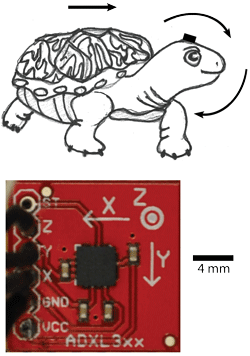URMC / Labs / Holt Lab / Projects / Behavioral-Assessment-of-Efferent-Function
Behavioral Assessment of Efferent Function

Recording head movements in an alert animal. We are evaluating the use of
MEMS-based accelerometers (lower panel) and gyroscopes as detectors of
head movements in freely behaving animals. We will first need to
characterize normal vestibular behaviors before addressing the role of the
efferent system. Disrupting the efferent system then can be done
pharmacologically and/or surgically. Artwork courtesy of Erika Bruss.
The first three projects provide us with a wealth of information regarding the activity and synaptic actions of vestibular efferent neurons and how they might impinge upon vestibular processing. However, there is very little information about how efferents are working in animals performing normal vestibular tasks such as walking or turning their head. We have a number of pharmacological agents that can be used to interact with different components of the vestibular efferent system simply by local application into the peripheral vestibular labyrinth. Given that efferent neurons travel in a distinct bundle, surgical measures can also be implemented to disrupt efferent function. Either intervention first requires characterizing normal behavioral responses to various vestibular stimulation paradigms. We are currently utilizing MEMS technology to develop devices capable of monitoring these responses. Our plans are to monitor head movements including rotation and translation as well as eye-movements. Once baseline measurements have been established for our vestibular model, we can then compare them with models where efferent neurons have been surgically ablated or pharmacologically altered.
« back to all projects